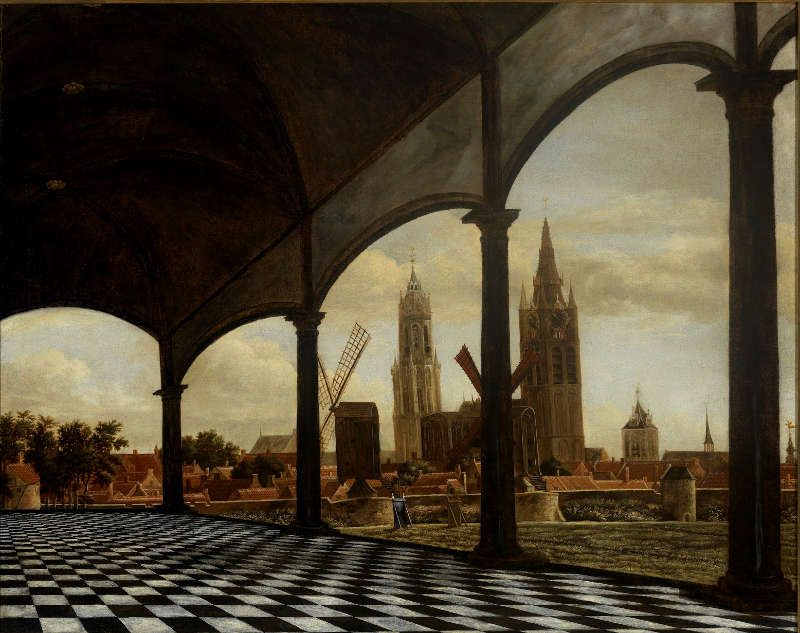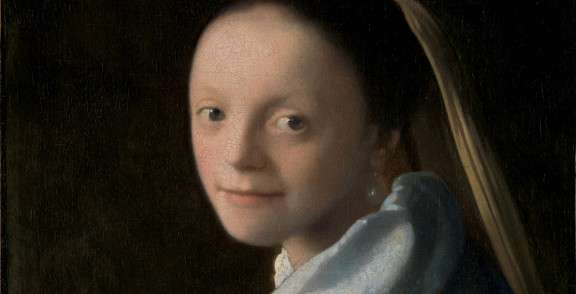IN BRIEF
exhibitions
- Art historian and Vermeer Albert Blankert passes away
- 2023 Amsterdam Vermeer retrospective tickets now available
- Vermeer's Officer and Laughing Girl travels to The Hague
- The Lacemaker exhibited in Dallas Texas
- The National Gallery of Art stages a Vermeer-related exhibition and proclaims the Girl with Flute is not by Vermeer
- Vermeer's Milkmaid: Discoveries
- The Frick Collection publishes the most comprehensive study to date on Vermeer and maps
- Dutch Vermeer-related reality show: De Nieuwe Vermeer
EXHIBITION
1.
Dutch art historian and Vermeer expert dies
Albert Blankert - 16 June, 1940 - 22 November, 2022
Dutch art historian and expert in 17th century Dutch painting and the art of Johannes Vermeer. Slade Professor of Fine Art at the University of Cambridge from 1999 to 2000.
Albert Blankert was among the most authoritative modern Vermeer scholars and has written extensively both on Vermeer's art and Dutch painting. His influential, no-nonsense volume Johannes Vermeer van Delft, 1632–1675 (1975 ) contained a critical catalog and an important chapter on "Vermeer and His Public," in which for the first time attention was drawn to a group of collectors of the seventeenth, eighteenth and early nineteenth centuries who viewed Vermeer not so much as a "sphinx" but as a "first class painter." His essay, "Vermeer's Modern Themes and Their Traditions," in the catalog of the 1995/1996 Washington D.C./The Hague Vermeer exhibition, remains one of the most lucid iconographical studies of Vermeer's painting to date.
In his 1976 volume he included 31 authentic works by Vermeer and rejected 4 works which were, and still are, largely accepted by authoritative experts of Dutch painting: Woman with a Lute, Girl interrupted in her Music, Girl with a Red Hat and Girl with a Flute. He also excluded the Young Woman Seated at the Virginals (Leiden Collection, New York) and Saint Praxedis (National Museum of Western Art )from consideration.
I was never able to meet Albert personally but would like to remember him via an answer he gave in an interview that he kindly granted to the Essential Vermeer in 2005.
"We appreciate, like, admire, love Vermeer's work a very great deal. We want to express all this in words and find them insufficient, so we sing, jubilate, dance, scream, paint, drum, yes, similar to what we do for a loved one or for a god, what is the difference? Personally I find that we should observe utter restraint, but in how far is that a rational stance?"
an interview with Albert (2005)
Essential Vermeer
<http://www.essentialvermeer.com/interviews_newsletter/albert_blankert_interview.html>
"Specialism with a human face" (2004)
Gary Schwartz Art Historian: Art History from Holland
<http://www.garyschwartzarthistorian.nl/210-specialism-with-a-human-face/>
"Vermeeren of verminderen: in memory of Albert Blankert" (2022)
Gary Schwartz Art Historian: Art History from Holland
<http://www.garyschwartzarthistorian.nl/411-vermeeren-of-verminderen-in-memory-of-albert-blankert/>
essential bibliography:
- Johannes Vermeer van Delft, 1632, 1675 with the collaboration of Rob Ruurs and Willem L. Vvan de Wetering, 1975
- Vermeer, Albert Blankert, John Michael Montias, Gilles AillaudI, Rob Ruurs, Willem van de Watering, and Philip Resche Rigon, Amsterdam, (English ed. New York, 1988)
- "Vermeer's Modern Themes and Their Tradition" in Johannes Vermeer. eds. Arthur K. Wheelock Jr. and Ben Broos. National Gallery of Art, New Haven and London: Yale University Press 1995.
- "An adjustable leg and a book: Vermeer's Lacemaker compared to others." Albert Blankert, and Louis P. Grijp. in Shop Talk: Studies in Honor of Seymour Slive, 1995
EXHIBITION
2.
Tickets available to the Vermeer retrospective in February 2023
Vermeer
Rijksmuseum, Amsterdam
February 10-June 4, 2023
open daily from 9:00 to 18:00
Tickets are now available for the 2023 Vermeer retrospective at the Rijksmuseum, Amsterdam
the latest news addition:
The Rijksmuseum has made public the paintings by Vermeer that will be on display at the retrospective of his works beginning 10 February, 2023. Although the Rijksmuseum is sticking with the figure of 28 paintings, its curators have a lingering hope that one or two absentees might still be coaxed into the exhibition before the opening. The Girl with a Pearl Earring will be shown only for the first two months of the exhibit. But no need to despair, it will return to the Mauritshuis in The Hague, only a short train ride to Amsterdam. The major absentee is The Art of Painting, the closest thing to what you could call a "manifesto" of his profession.
To see which paintings will and won’t be in the exhibit, visit my Instagram post on that here:
<https://www.instagram.com/p/CkdnTsmIJYE/>
exhibition news:
<https://www.rijksmuseum.nl/en/whats-on/exhibitions/vermeer/story/the-largest-vermeer-exhibition-ever>
tickets (start time required):
<https://www.rijksmuseum.nl/en/whats-on/exhibitions/vermeer/>
 View of Delft with a Fantasy Loggia
View of Delft with a Fantasy Loggia
Daniël Vosmaer
1663
Oil on canvas
Museum Prinsenhof Delft (loan from the Cultural Heritage Agency)
EXHIBITION
3.
Vermeer's Officer and Laughing Girl exhibited at The Hague Mauritshuis
Manhattan Masters
Frick Collection, New York City
September 29, 2022 - January 15 , 2023
<https://www.mauritshuis.nl/en/what-s-on/exhibitions/manhattan-masters/>
The Mauritshuis Anniversary year concludes with a special exhibition: ten paintings from The Frick Collection in New York. This will be a one-time opportunity to view this selection of paintings in Europe, which (with one exception) left the continent more than a hundred years ago and have been in the United States ever since.
Of the ten paintings in the exhibition, Vermeer's Officer and Laughing Girl and Rembrandt’s 1658 Self-portrait will be the absolute highlights.
tickets:
<https://tickets.mauritshuis.nl/en/tickets>
Vermeer's Lacemaker visits Dallas
Dalí/Vermeer: A Dialogue
Meadows Museum, Dallas TX
October 16, 2022-January 15, 2023
<https://meadowsmuseumdallas.org/exhibitions/dali-vermeer-a-dialogue/>
from the Meadows Museum website:
Thanks to the generosity of the Fundació Gala-Salvador Dalí in Figueres, Spain, and the Rijksmuseum in Amsterdam, Dalí/Vermeer: A Dialogue, unites Johannes Vermeer’s Woman in Blue Reading a Letter (c. 1663) and Salvador Dalí’s interpretation thereof, The Image Disappears (1938), for the very first time.
A key part of any artist’s formal training has always been the study of their predecessors’ works, the imitation of which is seen as a crucial step in the development of one’s own style and technique. Dalí stands out as among the modern artists who most revered—indeed obsessed over—the painters that preceded him. The famed surrealist came of age just as earlier painters were being celebrated and publicized outside of their countries of origin, as was the case with the Dutch painter Vermeer, whose work he at first knew only through reproductions.
While a kind of Vermeerian iconography would come to pepper Dalí’s compositions throughout his career, less common are the instances in which the Surrealist painter reinterpreted whole compositions by Vermeer. Among these is The Image Disappears, Dalí’s interpretation of Vermeer’s Woman in Blue Reading a Letter. In The Image Disappears, whose title describes what the image does rather than what it depicts, Dalí takes the basic forms and elements of Vermeer’s composition—a woman wearing a blue night jacket, standing in profile reading a letter in front of an unseen window from which emanates soft light—and plays a visual trick on viewers, creating a second image of a mustachioed male face in profile that has been identified as that of Velázquez.
Not even Dalí would have seen these two paintings side-by-side; thus, the exhibition offers the unique opportunity to contemplate imitator and imitated within the context of the Meadows’s collection of Spanish art. The Meadows welcomes visitors to not only enjoy this rare moment to see a Vermeer in Texas, but to contemplate the broader question of imitation: is it flattery or conceit?
Additional works by Dalí from the Meadows’s collection, including works on paper, will be featured elsewhere in the museum and round out this fall’s celebration of the artist and his many evocations of art historical themes.
Vermeer exhibition at the National Gallery, Washington D. C. The Gallery claims Girl with a Flute is not by Vermeer's hand
Vermeer’s Secrets
National Gallery of Art, Washington D. C.
October 8, 2022 – January 8, 2023
<https://www.nga.gov/press/exhibitions/exhibitions-2022/5675.html>
from the National Gallery website:
Only about 35 paintings by Johannes Vermeer are known today. The National Gallery owns four works by or attributed to this beloved 17th-century Dutch artist: Woman Holding a Balance, A Lady Writing, Girl with the Red Hat, and Girl with a Flute.
Friday, October 7, the Gallery announced that on the basis of new research done in the past two years the Girl with a Flute has been definitively proven to be the product of someone likely close to Vermeer, but not the painter himself. The Gallery now believes that the work originated in the “studio of Vermeer,” which, however nothing is known about.
According to the Gallery:
"The mystery artist who painted Girl with a Flute was familiar with Vermeer’s unique methods and materials, but unable to achieve his level of expertise. He may have been a pupil or apprentice in training, an amateur who paid Vermeer for lessons, a freelance painter hired on a project-by-project basis, or even a member of Vermeer’s family.
"This exciting notion of a studio calls into question the long-held idea of Vermeer as a lone genius. On the contrary, he might have been a mentor and educator, training a future generation of artists.
"For decades, conservators, scientists, and curators at the National Gallery have conducted research into this quartet of paintings as well as two enigmatic works that are now considered to be 20th-century forgeries. Vermeer’s Secrets draws on 50 years of imaging technology and microscopic examination to illuminate—and sometimes revolutionize—our understanding of how Vermeer achieved the compelling effects of his paintings’ light-filled moments of quiet solitude.
"The exhibition incorporates vivid technical images made using innovative technologies pioneered by two leaders in the field of scientific imaging, the National Gallery’s senior imaging scientist John K. Delaney and imaging scientist Kathryn A. Dooley. Using hyperspectral reflectance imaging techniques first developed to map minerals for remote sensing of the earth and subsequently the moon and Mars, as well as X-ray fluorescence imaging spectroscopy, Delaney and Dooley are able to identify and map pigments and also reveal what lies beneath the surface of a painting. While earlier technical examination (magnified examinations of the paintings, analysis of microsamples, and X-ray fluorescence spot analysis) allowed Melanie Gifford and Lisha Glinsman to hypothesize the stages in Vermeer’s working methods, these advancements in imaging technologies provided the opportunity to try and visualize those stages. The resulting images allowed the team to analyze the distribution of pigments across the paintings, distinguish compositional changes, and in the case of the Girl with the Red Hat, reveal more details about an earlier unfinished bust-length portrait of a man with a wide-brimmed hat."
NGA articles:
- "Methodology & Resources: New Findings from the National Gallery of Art," E. Melanie Gifford, Kathryn A. Dooley, John K. Delaney, Journal of Historians of Netherlandish Art 14:2 (Summer 2022)
<https://jhna.org/articles/vermeer-methodology-resources/>
- "First Steps in Vermeer’s Creative Process: New Findings from the National Gallery of Art," E. Melanie Gifford, Dina Anchin, Alexandra Libby, Marjorie E. Wieseman, Kathryn A. Dooley, Lisha Deming Glinsman, John K. Delaney, Journal of Historians of Netherlandish Art 14:2 (Summer 2022)
<https://jhna.org/articles/first-steps-in-vermeers-creative-process/>
- "Experimentation and Innovation in Vermeer’s Girl with the Red Hat: New Findings from the National Gallery of Art," Alexandra Libby, E. Melanie Gifford, Dina Anchin, Marjorie E. Wieseman, Kathryn A. Dooley, Lisha Deming Glinsman, John K. Delaney, Journal of Historians of Netherlandish Art 14:2 (Summer 2022)
<https://jhna.org/articles/experimentation-and-innovation-in-vermeers-girl-with-the-red-hat/>
- "Vermeer’s Studio and the Girl with a Flute: New Findings from the National Gallery of Art," Marjorie E. Wieseman, Alexandra Libby, E. Melanie Gifford, Dina Anchin, Journal of Historians of Netherlandish Art 14:2 (Summer 2022)
<https://jhna.org/articles/vermeers-studio-and-the-girl-with-a-flute/>
- "Methodology & Resources: New Findings from the National Gallery of Art," E. Melanie Gifford, Kathryn A. Dooley, John K. Delaney,Journal of Historians of Netherlandish Art 14:2 (Summer 2022)
<https://jhna.org/articles/vermeer-methodology-resources/>





 View of Delft with a Fantasy Loggia
View of Delft with a Fantasy Loggia or anything else that isn't working as it should be, I'd love to hear it! Please write me at:
or anything else that isn't working as it should be, I'd love to hear it! Please write me at: